The AMD Radeon R9 270X & R9 270 Review: Feat. Asus & HIS
by Ryan Smith on November 13, 2013 12:01 AM ESTCompute
Jumping into compute, we’re once again treading into familar territory. Pitcairn is Pitcairn is Pitcairn, and for the 270 series this will result in the same general performance increases we've seen elsewhere. 270 will of course be the bigger winner, owing to its upgrade to a fully enabled Pitcairn part. Also, on a quick housekeeping note we'll only be looking at the HIS 270 here. Our primary interest is on a broad architectural basis, rather than the minor impact from factory overclocks.
As always we'll start with our DirectCompute game example, Civilization V, which uses DirectCompute to decompress textures on the fly. Civ V includes a sub-benchmark that exclusively tests the speed of their texture decompression algorithm by repeatedly decompressing the textures required for one of the game’s leader scenes. While DirectCompute is used in many games, this is one of the only games with a benchmark that can isolate the use of DirectCompute and its resulting performance.
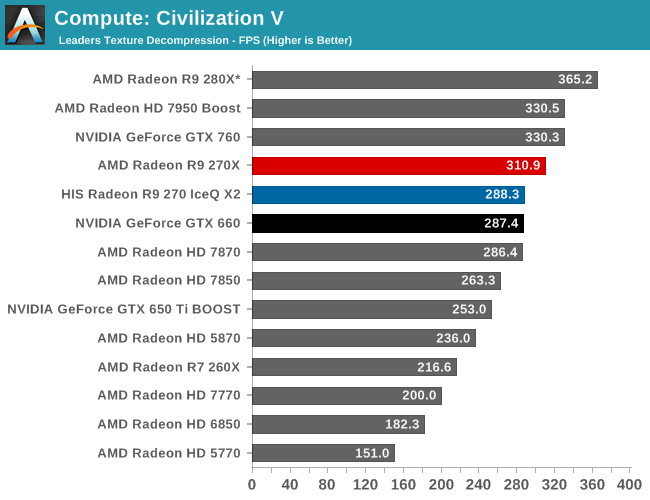
Both 270 cards do well for themselves here. The 270X holds the overall edge of course, though it’s interesting to note that the 270 and GTX 660 are virtually tied here.
Our next benchmark is LuxMark2.0, the official benchmark of SmallLuxGPU 2.0. SmallLuxGPU is an OpenCL accelerated ray tracer that is part of the larger LuxRender suite. Ray tracing has become a stronghold for GPUs in recent years as ray tracing maps well to GPU pipelines, allowing artists to render scenes much more quickly than with CPUs alone.
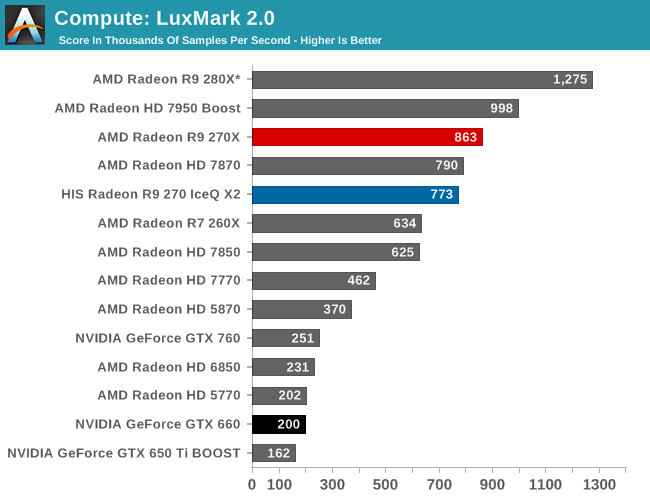
AMD consistently rules the roost on LuxMark, so there aren’t any surprises here. This chart is essentially just the AMD GCN cards sorted by performance, followed by their older VLIW cards and the GeForce cards.
Our 3rd compute benchmark is Sony Vegas Pro 12, an OpenGL and OpenCL video editing and authoring package. Vegas can use GPUs in a few different ways, the primary uses being to accelerate the video effects and compositing process itself, and in the video encoding step. With video encoding being increasingly offloaded to dedicated DSPs these days we’re focusing on the editing and compositing process, rendering to a low CPU overhead format (XDCAM EX). This specific test comes from Sony, and measures how long it takes to render a video.
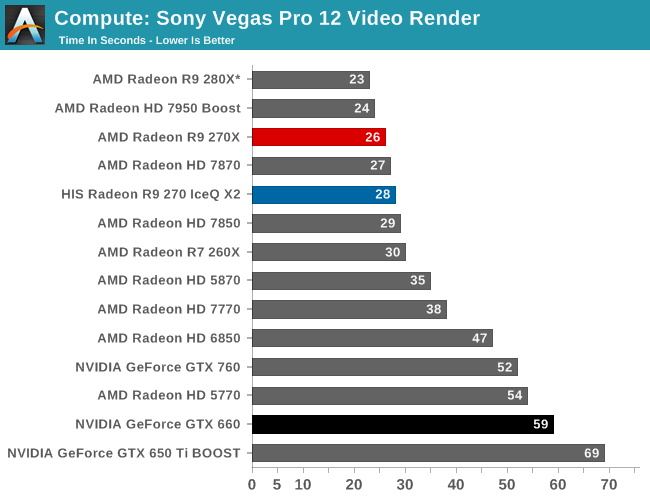
Like LuxMark, Sony Vegas is a benchmark dominated by AMD. The lead here is so great that the 270 could run this benchmark twice over before the GTX 660 completed it once.
Our 4th benchmark set comes from CLBenchmark 1.1. CLBenchmark contains a number of subtests; we’re focusing on the most practical of them, the computer vision test and the fluid simulation test. The former being a useful proxy for computer imaging tasks where systems are required to parse images and identify features (e.g. humans), while fluid simulations are common in professional graphics work and games alike.
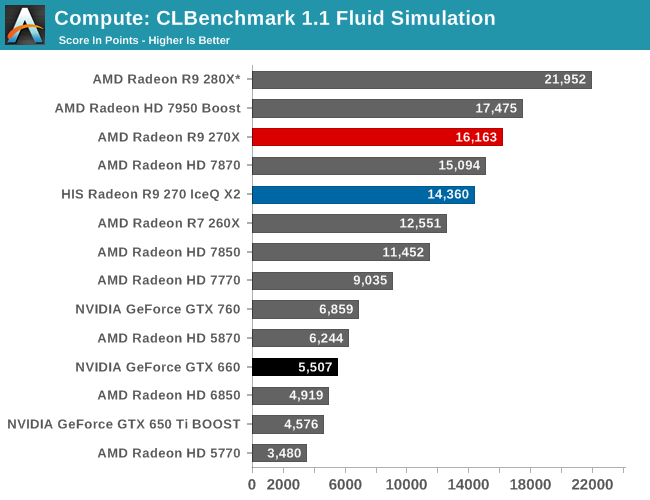
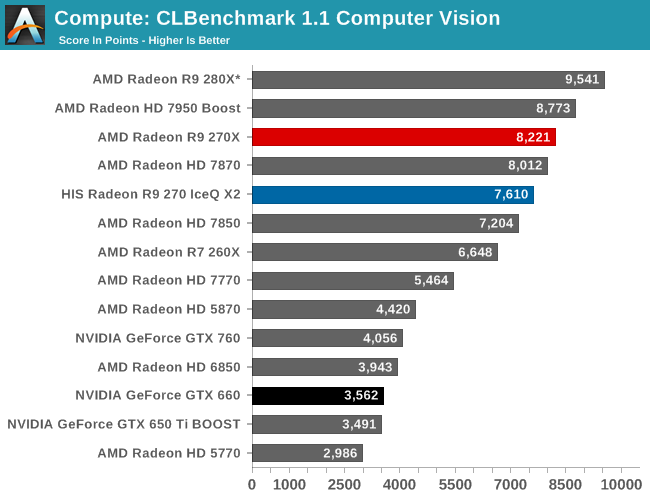
Both CLBenchmark’s fluid simulation benchmark and the computer vision benchmark go to AMD here. The GTX 660 and GTX 760 are not competitive here.
Moving on, our 5th compute benchmark is FAHBench, the official Folding @ Home benchmark. Folding @ Home is the popular Stanford-backed research and distributed computing initiative that has work distributed to millions of volunteer computers over the internet, each of which is responsible for a tiny slice of a protein folding simulation. FAHBench can test both single precision and double precision floating point performance, with single precision being the most useful metric for most consumer cards due to their low double precision performance. Each precision has two modes, explicit and implicit, the difference being whether water atoms are included in the simulation, which adds quite a bit of work and overhead. This is another OpenCL test, as Folding @ Home has moved exclusively to OpenCL this year with FAHCore 17.
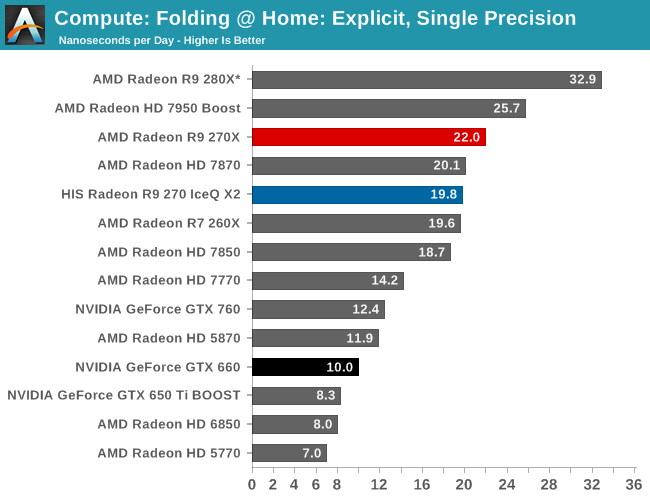
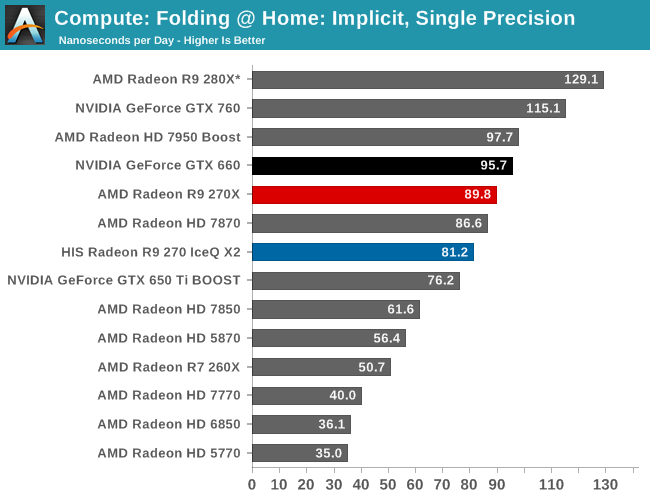
When it comes to Folding@Home, the winner is highly dependent on the specific test. For the explicit simulation the GTX 660 is a significant laggard, leaving the 270 series to take the top spots for sub-$200 cards. In the implicit test however none of the 270 cards can hold their ground against the GTX 660, not even the 270X. Folding@Home uses a mix of these data types so there won’t be any one clear winner, but the 270 series loses by a smaller margin in implicit than the GTX 660 does in explicit.
Wrapping things up, our final compute benchmark is an in-house project developed by our very own Dr. Ian Cutress. SystemCompute is our first C++ AMP benchmark, utilizing Microsoft’s simple C++ extensions to allow the easy use of GPU computing in C++ programs. SystemCompute in turn is a collection of benchmarks for several different fundamental compute algorithms, as described in this previous article, with the final score represented in points. DirectCompute is the compute backend for C++ AMP on Windows, so this forms our other DirectCompute test.
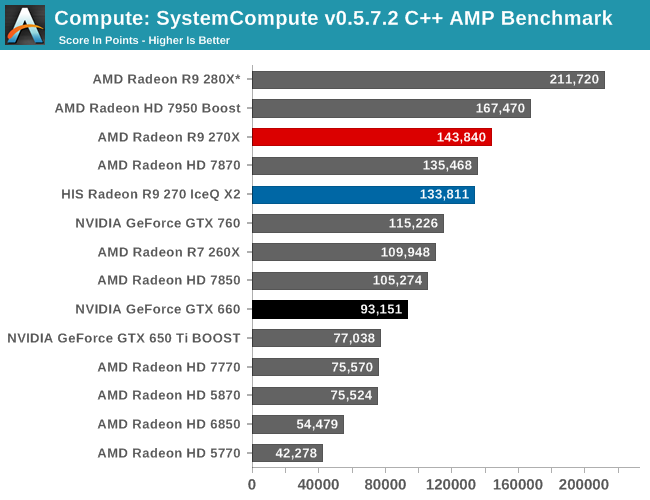
SystemCompute is another compute benchmark that goes to AMD. The 270 and 270X handily beat the GTX 760, never mind the GTX 660.










59 Comments
View All Comments
Will Robinson - Wednesday, November 13, 2013 - link
What!...no hatchet job on these new cards from Wreckage?The hurt just keeps on coming eh Wrecky?
just4U - Thursday, November 14, 2013 - link
It's not beating the 760 so his stocks are safe... for now. Besides, you need to give him a break. Poor man must be tired after the release of the 780Ti and 290/X.geniekid - Wednesday, November 13, 2013 - link
Would really have liked to see CFX numbers.Da W - Wednesday, November 13, 2013 - link
Agreed, i need to compare 270X crossfire performance/heat/noise to a single 290X.Right now i'm hesitating, for my 3 monitor setup:
1. Dual 270X for 400$. -Advantage of lower cost, lower heat, lower noise, turn off one GPU when not gaming. Don't know if it's strong enough for 3600X1920.
2. Single 290 for 450$. -Best price/performance, noisy, hot.
3. Single GTX 780 superclocked for 530$. - If only for Nvidia cooler and energy efficiency, else i'm an AMD guy.
4. Single 290X for 550$. -I would pick this over vanilla 290 for chip binning, it should have higher quality GPU as far as energy concumption goes.
Titan and 780ti are above my budget.
garadante - Wednesday, November 13, 2013 - link
I'm strongly doubting two of these would game at 3600x1920 comfortable. That's almost 4k resolution. Remember that any AMD card below the 290 series still uses the Crossfire bridge and can't transfer 4k resolution frame buffers through it. Making the second card completely useless as the buffer is just dropped instead. And I haven't seen technical info yet, but I wonder if that's part of the reason why the 290 series outperforms the 780/780 Ti in 4k gaming so well. Perhaps the SLI bridge is also becoming a bottleneck, depending on how it handles frame buffers.For that resolution, personally I'd say waiting for aftermarket 290s and 290Xs would be a good choice. Get either much better binned chips in a high end aftermarket 290 or 290X, better thermals, and acoustics for both (and thus better overclocking headroom). With the performance those cards were getting at 4K gaming, they could probably handle single card 3600x1920 at decent settings, though probably not highest without dropping significantly below 60 FPS. But it leaves room for adding a 2nd card, whereas starting with 270X doesn't. Looks like it only has 1 Crossfire bridge which means you can't add a third card.
Da W - Wednesday, November 13, 2013 - link
Good advice. I'll discard option number 1 then, and yes i'm waiting until we see custom coolers on the 290 series before i make a move, probably an MSI one to match my MB. Although that Nvidia cooler is cool looking as hell.....At "3.5K", i find that disabling AA or adjusting just a step below "ultra freaking high details" makes all games playable. By playable i mean above 30FPS.
krumme - Wednesday, November 13, 2013 - link
Where is the noise equalization test?It looks like the asus card is around 853% faster than the nearest competitor.
Streetwind - Wednesday, November 13, 2013 - link
Ryan, will you be adding the results from the various R7/R9 models tested in the last month or two to Bench eventually? The entire new series is absent so far, as is the GTX 780 Ti. I often use Bench for comparing my current card to potential upgrades, so it would be great to have.Ryan Smith - Wednesday, November 13, 2013 - link
Yes. GPU14 Bench will be up next week; I need to clean up the DB a bit first.yacoub35 - Wednesday, November 13, 2013 - link
So how come no mention of the 7950 in the conclusion? It's clearly the right choice, as you get 3GB of VRAM in addition to superior performance, and all for a price well under $200.